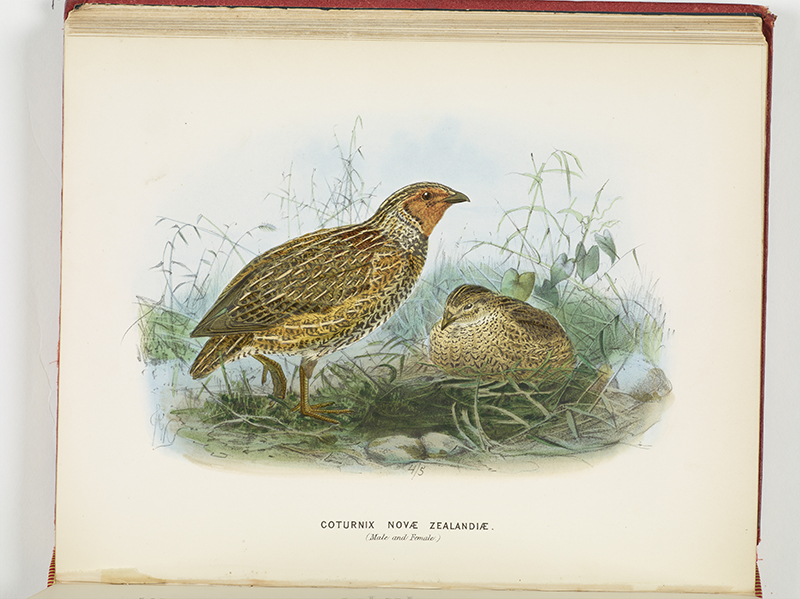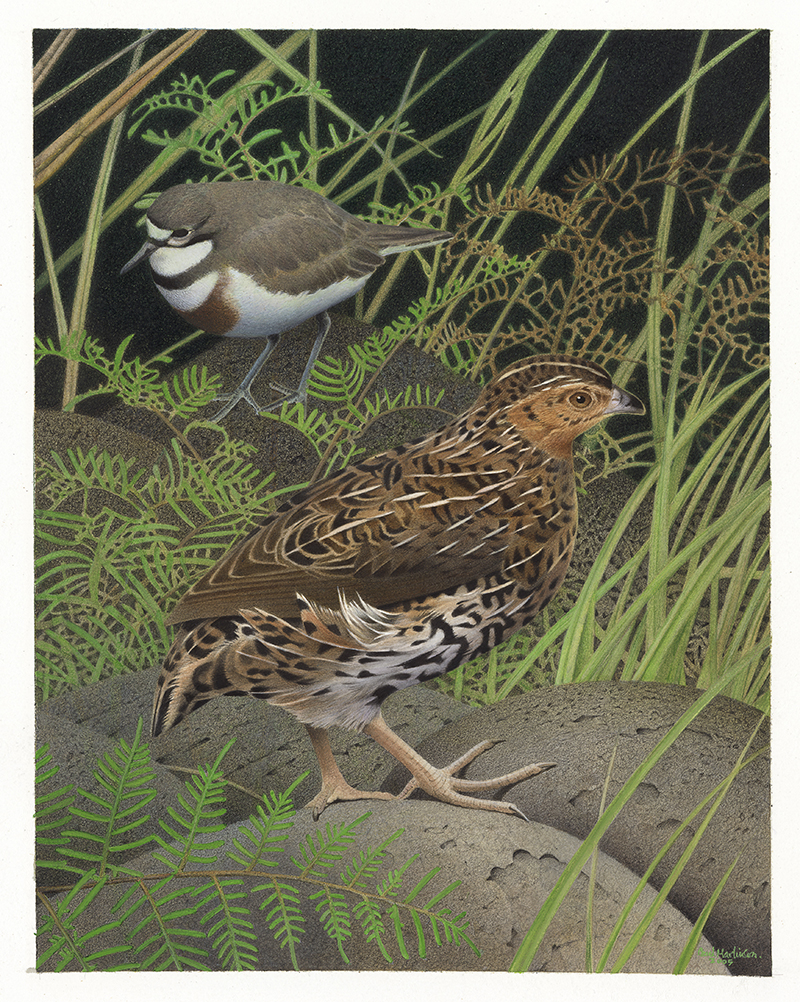Coturnix novaezelandiae Quoy & Gaimard, 1830:242
New Zealand quail, Koreke (Māori)
Taxonomy & Nomenclature
Complete synonymy from (Checklist Committee (OSNZ), 2022:39):
Coturnix Novae-Zelandiae Quoy & Gaimard, 1830: in Dumont d’Urville, Voyage Astrolabe Zool. 1: 242, pl. 24, fig. 1 – Hauraki Gulf.; Coturnix Novae Zealandiae Quoy & Gaimard; G.R. Gray 1843, in E. Dieffenbach, Travels in N.Z. 2: 195. Unjustified emendation.; Coturnix Novae Zelandiae Quoy [sic]; Anon. 1870, Cat. Colonial Mus.: 74. Unjustified emendation.; Coturnix novae zealandiae Quoy & Gaimard; Buller 1872 (Dec.), History of the Birds of N.Z., 1st edition (part 3): 161. Unjustified emendation.; Coturnix novae-zealandiae Quoy & Gaimard; Travers 1883, Trans. Proc. N.Z. Inst. 15: 186. Unjustified emendation.; Coturnix novaezealandiae Quoy & Gaimard; Mathews & Iredale 1913, Ibis 1 (10th series): 207. Unjustified emendation.; Zecoturnix novae-zelandiae (Quoy & Gaimard); Mathews 1930, Emu 29: 279.; Coturnix novaezealandiae pounami Mathews, 1944: Emu 43: 247 – Port Cooper, Canterbury. Unjustified emendation.; Coturnix novaezealandiae novaezealandiae Quoy & Gaimard; Checklist Committee 1953, Checklist N.Z. Birds: 37. Unjustified emendation.; Coturnix novaezelandiae novaezelandiae Quoy & Gaimard; Checklist Committee 1990, Checklist Birds N.Z.: 115.; Coturnix novaezelandiae Quoy & Gaimard; Marchant & Higgins 1993, HANZAB 2: 402.
Conservation Status
Extinct (WCMC, 1992:211)
Last record: 1860-1870 (North Island) (Buller, 1883, 1905); December 1869 (North Island) (sighting) (Checklist Committee (OSNZ), 2022:39); 1867-1868 (South Island) (specimens) (Checklist Committee (OSNZ), 2022:39); 1875 (South Island) (sighting) (Buller, 1883; WCMC, 1992:211; Checklist Committee (OSNZ), 2022:39; Kittelberger et al., 2024)
IUCN RedList status: Extinct
"Still common by 1848, when as many as 86 could be shot on one day; on the verge of extinction by 1870. The last North Island sighting was Dec. 1869; the last reliable South Island observation was in 1875, with latest specimens collected 1867 or 1868. The reasons for the disappearance are uncertain but it coincides with the establishment of cats and probable ongoing predation by Norway rats (Tennyson & Martinson 2007: 11, 64, 143, 149)."
(Checklist Committee (OSNZ), 2022:39)
Distribution
New Zealand (North, South & Great Barrier Islands)
Biology & Ecology
Hypodigm
[url=http://nlbif.eti.uva.nl/naturalis/detail.php?lang=uk&id=46]RMNH 110.051[/url] (male)
[url=http://nlbif.eti.uva.nl/naturalis/detail.php?lang=uk&id=46]RMNH 110.052[/url] (female)
The Whanganui Regional Museum, North Island, New Zealand has at least one specimen ([url=https://www.nzherald.co.nz/history/news/article.cfm?c_id=500832&objectid=12088958]source[/ur]).
Media

Above: Coturnix novae zealandiae (Male and Female). Plate 19. From the book A history of the birds of New Zealand., 1873, by Johannes Keulemans. Te Papa (RB001176/019a)

Above: New Zealand Quail / Koreke. Coturnix novaezelandiae. From the series: Extinct Birds of New Zealand., 2005, Masterton, by Paul Martinson. Purchased 2006. © Te Papa. CC BY-NC-ND 4.0. Te Papa (2006-0010-1/38)
References
Original scientific description:
Quoy, M. M. and Gaimard, P. (1830). [description of Coturnix novaezelandiae]. Voyage de l'Astrolabe, Zoologie, volume 1, p. 242. Paris: J. Tastu, Éditeur-Impremeur.
Other references:
BirdLife International. (2012). Coturnix novaezelandiae. In: IUCN 2012. IUCN Red List of Threatened Species. Version 2012.2. (http://www.iucnredlist.org). Downloaded on 20 May 2013.
BirdLife International. 2016. Coturnix novaezelandiae. The IUCN Red List of Threatened Species 2016: e.T22678955A92795779. https://dx.doi.org/10.2305/IUCN.UK.2016-3.RLTS.T22678955A92795779.en. Accessed on 20 June 2022.
Buller, W. L. (1872). A History of the Birds of New Zealand, first edition. pl. 18.
Buller, W. L. (1887-1888). A History of the Birds of New Zealand, 2 volumes. London: Taylor & Francis.
Buller, W. L. (1883). On some rare species of New Zealand birds. Trans. N.Z. Institute 16: 308-318.
Buller, W. L. (1905). Supplement to a histary of the birds of New Zealand. Publ. by the author, London.
Checklist Committee (OSNZ). (2010). Checklist of the Birds of New Zealand, Norfolk and Macquarie Islands, and the Ross Dependency, Antarctica (4th ed.). Ornithological Society of New Zealand & Te Papa Press, Wellington. [p. 26, 355]
Checklist Committee (OSNZ). (2022). Checklist of the Birds of New Zealand (5th edition). Ornithological Society of New Zealand Occasional Publication No. 1. Wellington: Ornithological Society of New Zealand. [p. 39]
Day, David. (1981). The Doomsday Book of Animals: A Natural History of Vanished Species. New York, N.Y.: The Viking Press.
Dickinson, E.C. (Ed.). 2003. The Howard and Moore complete checklist of the birds of the world. Revised and enlarged third edition. Princeton and Oxford: Princeton University Press. 1040 pp.
Fleming, C. A. and Lodge, G. E. (1983). George Edward Lodge, Unpublished Bird Paintings. pl. 43.
Forshaw, Joseph M. (2023). Quail, Buttonquail and Plains-wanderer in Australia and New Zealand. Clayton South, Melbourne: CSIRO Publishing. 200 pp.
Fuller, Errol. (1988). Extinct Birds. New York: Facts on File Publications. 256 pp.
Gill, Brian James. (1984). Specimens of rare or recently extinct New Zealand non-passerine birds in the Auckland Institute and Museum. Rec. Auckland Inst. Mus. 21(1): 77-82.
Holdaway, R. N. 1999. Introduced predators and avifaunal extinction in New Zealand. In: MacPhee, R.D.E. (ed.), Extinctions in near time: causes, contexts and consequences, pp. 189-238. Plenum Press, New York.
Holdaway, Richard N., Worthy, Trevor H. and Tennyson, Alan J. D. (2001). A working list of breeding bird species of the New Zealand region at first human contact. New Zealand Journal of Zoology 28: 119-187.
Hume, Julian Pender and Walters, Michael. (2012). Extinct Birds. London: T & AD Poyser.
Jouanin, Christian. (1962). Inventaire des oiseaux éteints ou en voie d’extinction conservés au Muséum de Paris. Terre et Vie 109: 275-301.
Kittelberger, Kyle D., Tanner, Colby J., Buxton, Amy N., Prewett, Amira and Şekercioğlu, Çağan Hakkı. (2024). Correlates of avian extinction timing around the world since 1500 CE. Avian Research 15: 100213. https://doi.org/10.1016/j.avrs.2024.100213 [Supplementary data (List of 216 taxa)]
Knox, Alan G. and Walters, Michael P. (1994). Extinct and endangered birds in the collections of The Natural History Museum. British Ornithologists' Club Occasional Publications 1: 1-292.
Marchant, S.; Higgins, P. J. 1993. Handbook of Australian, New Zealand and Antarctic birds, 2: raptors to lapwings. Oxford University Press, Melbourne.
Marples, B. K. (1946). List of the birds of New Zealand. Notornis 1(supp.): i-vii.
McGlone, M. S.; Anderson, A. J.; Holdaway, R. N. (1994). An ecological approach to the Polynesian settlement of New Zealand, pp. 136-163 in: Sutton, D. G. (ed.) The origins of the first New Zealanders. Auckland, Auckland University Press. 269 pp.
Millener, P. R. (1981). The Quaternary avifauna of the North Island, New Zealand. Unpublished PhD thesis. Department of Geology, University of Auckland, Auckland, New Zealand. 897 pp.
Miskelly, C. M. (1999). Mana Island Ecological Restoration Plan. Wellington, Department of Conservation.
Oliver, W. R. B. (1955). New Zealand birds. Second edition. Wellington: A.H. & A.W. Reed. 661 pp.
Potts, T. H. (1870). On the birds of New Zealand. Transactions and Proceedings of the New Zealand Institute 2: 40-78.
RAOU Checklist Amendment Committee. 1978. Second amendments to the 1975 RAOU checklist. Emu 78: 80-87.
Richardson, J. and Gray, G. R. (1844-75). The Zoology of the Voyage of H. M.S. Erebus and Terror, unde command of Captain Sir James Clark Ross, R.N. pl. 8.
Robertson, H. A., Baird, K. A., Elliott, G. P., Hitchmough, R. A., McArthur, N. J., Makan, T. D., Miskelly, Colin M., O’Donnell, C. F. J., Sagar, P. M., Scofield, R. P., Taylor, G. A. and Michel, P. (2021). Conservation status of birds in Aotearoa New Zealand, 2021. New Zealand Threat Classification Series 36. Department of Conservation, Wellington. 43 pp.
Hugh Robertson, John Dowding, Graeme Elliott, Rod Hitchmough, Colin Miskelly, Colin O’Donnell, Ralph Powlesland, Paul Sagar, Paul Scofield, Graeme Taylor. (2013). Conservation status of New Zealand birds, 2012. New Zealand Threat Classification Series 4. 22 pp.
Rothschild, Lionel Walter. (1907). Extinct birds: an attempt to write in one volume a short account of those birds which have become extinct in historical times, that is within the last six or seven hundred years: to which are added a few which still exist, but are on the verge of extinction. London: Hutchinson & Co. XXIX + 243 pp. [p. 183-184, pl. 28]
Sayol, Ferran, Steinbauer, Manuel J., Blackburn, Tim M., Antonelli, Alexandre and Faurby, Søren. (2020). Anthropogenic extinctions conceal widespread evolution of flightlessness in birds. Science Advances 6(49): eabb6095. https://doi.org/10.1126/sciadv.abb6095 [Supplementary Material (Data File S1)]
Seabrook-Davison, M., Huynen, L., Lambert, D.M. and Brunton, D.H. (2009). Ancient DNA resolves identity and phylogeny of New Zealand's extinct and living quail (Coturnix sp.). PLoS One 4(7): e6400.
Shuker, Karl. (2014, 27 October). My very own crypto-bird? - Quailing at the potential rediscover of a long-lost species. Blog post at shukernature, available from here: http://www.karlshuker.blogspot.co.uk/2013/10/my-very-own-crypto-bird-quailing-at.html
Smith, Ian. (1999). Settlement Permanence and Function at Pleasant River Mouth, East Otago, New Zealand. New Zealand Journal of Archaeology 19: 27-79.
Tennyson, Alan J. D. and Martinson, P. (2006). Extinct Birds of New Zealand. Te Papa Press, Wellington. vi + 180 pp.
Tennyson, A.J.D. & Martinson, P. 2007. Extinct birds of New Zealand. Revised edition. Wellington: Te Papa Press. vi + 180 pp.
Trotter, M. M. (1965). Avian remains from North Otago archaeological sites. Notornis 12(3): 176-178.
Tyrberg, Tommy. (2009). Holocene avian extinctions, pp. 63-106. In: Turvey, Samuel T. (ed.). Holocene Extinctions. Oxford, UK & New York, USA: Oxford University Press. xii + 352 pp.
van Tets, G.F. 1978. Second amendments to the 1975 RAOU Checklist. Emu 78: 80-88.
WCMC (World Conservation Monitoring Centre). (1992). Global Biodiversity: Status of the Earth's living resources. London: Chapman & Hall. xx + 594 pp.
Williams, G. R. (1962). Extinction and the land and freshwater-inhabiting birds of New Zealand. Notornis 10(1): 15-32.
Williams, H.W. 1906. Maori bird names. Journal of the Polynesian Society 15: 193–208.
Worthy, Trevor H. (1993). Fossils of Honeycomb Hill. Museum of New Zealand, Te Papa Tongarewa, Wellington. 56 pp.
Worthy, Trevor H. (1998). Quaternary fossil faunas of Otago, South Island, New Zealand. Journal of the Royal Society of New Zealand 28(3): 421-521. https://doi.org/10.1080/03014223.1998.9517573 [p. 460]
Worthy, Trevor H. (2000). Two late-Glacial avifaunas from eastern North Island - Te Aute and Wheturau Quarry. Journal of the Royal Society of New Zealand 30(1): 1-26.
Worthy, T. H. and Holdaway, R. N. (1994). Quaternary fossil faunas from caves in Takaka Valley and on Takaka Hill, northwest Nelson, South Island, New Zealand. Journal of The Royal Society of New Zealand 24(3): 297-391.
Worthy, Trevor H. and Holdaway, Richard N. (1996). Quaternary fossil faunas, overlapping taphonomies, and palaeofaunal reconstruction in North Canterbury, South Island New Zealand. Journal of the Royal Society of New Zealand 26(3): 275-361.
Worthy, Trevor H. and Holdaway, Richard N. (2000). Terrestrial fossil vertebrate faunas from inland Hawke's Bay, North Island, New Zealand. Part 1. Records of the Canterbury Museum 14: 89-154.
https://extinctanimals.proboards.com/thread/6377/coturnix-novaezelandiae-new-zealand-quail
<< Back to the Galliformes (Francolins, Junglefowl, Mound-builders, Pheasants, Turkeys, etc.) database
